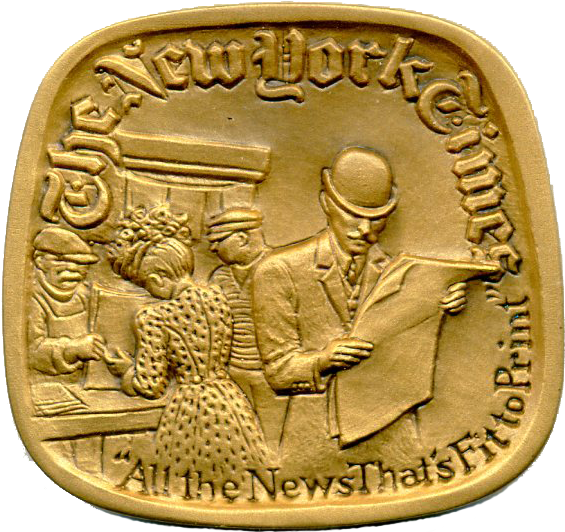 |  |
Adolph Ochs medal designed by Gerta Ries Wiener, struck by Johnson Matthey in quantities of 400 bronze, 60 pewter,
100 pure silver, and 24 10kt gold. Obverse: Portrait, Gerta Wiener. Reverse: Turn-of-the-century newsstand,
The New York Times, “All the News That’s Fit to Print.” 47 x 45 mm.
While Adolph Ochs’ formal education was sketchy, he described his work at the Knoxville (Tennessee) Chronicle as his “high school and university.” Beginning as office boy in 1869, at the age of 11, he was soon promoted to delivery boy at a weekly salary of $1.50. From that time until his death, Ochs never left the newspaper business. He was a founder of the Southern Associated Press, and was its chairman from 1891 to 1894. For 35 years, Ochs served as a director of the Associated Press.
At the age of 38, Ochs took on the monumental task of reviving the financially ailing New York Times. He insisted on a clean, upright and impartial approach to the news. After only three years of his dynamic leadership, The Times was showing a profit. Ochs purchased a controlling interest in 1900. Starting with a circulation of 9,000, The New York Times — at the time of Ochs’ death — sold almost a half million copies daily and nearly three-quarters of a million copies each Sunday. He had made it one of the greatest newspapers in the world.
Adolph Ochs headed the five million dollar campaign for the creation of Hebrew Union College’s endowment fund. He served as a trustee of Temple Emanu-El in New York, and as a symbol of interfaith goodwill. In 1930, Ochs presented two 12-foot candelabra (menorahs) to the Cathedral of St. John the Divine. Undoubtedly, Ochs’ greatest humanitarian effort was the creation of The New York Times Neediest Cases Fund in 1912, to provide money for “exceptionally deserving persons among the city’s poor.” That first year $3,630.88 was raised. Recent years have seen contributions mounting to several million dollars annually, donated by tens of thousands of Times’ readers. Every cent contributed goes to the needy, with no deductions for administrative costs. Thus, this son of immigrants — a lad who began his auspicious career by earning $1.50 a week at the age of 11 — has left a legacy that can make all Americans proud.